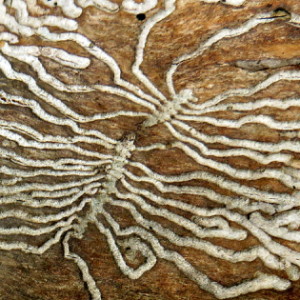Pattern recognition
I was delighted to see these engravings on an old tree stump. The main timber was sound as a nut but where the bark had been the surface was scored with a familiar pattern. These are the galleries of bark beetle* larvae. The adult female beetle lays her eggs in a row under the bark of an ailing or dead tree (ash in this case) and when they hatch the grubs start eating their way through the wood, their tunnels fanning out in different directions from the central trough in order not to bump into one another. The tunnels get wider as the larvae grow fatter. (See extra for detail.) When ready to pupate the grubs move up into the bark from whence they emerge as adults.
The beetles' signature always take me back to the age of 9 to 11 when I lived beside a timber yard. We had moved from rural Wales to a ramshackle house right beside a busy road junction in a Berkshire village. The next door neighbour ran a saw mill which screeched late into the summer evenings while across the road a shedful of young cockerels started crowing at 5 am. My parents were driven mad by the noise and pined for the peace we had left behind. But like all children I was curious about my new surroundings and spent hours jumping and clambering over the huge tree trunks lying around the timber yard in rotting heaps. It was fun to strip off the dry bark to reveal the incised fronds beneath.
I didn't know it then but it was the bark beetles that spread the Dutch Elm Disease that was to destroy most of Britain's elm trees in the 1970s. They didn't cause it directly but they acted as vectors for the fungal pathogen that changed the familiar appearance of the countryside forever.
* For anyone who wants to know more about Scolytus beetles there's a very readable account here.


Comments
Sign in or get an account to comment.


